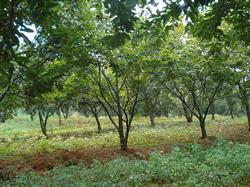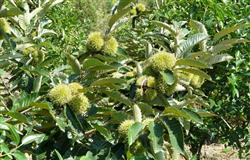How can chestnut trees be planted for high yield?

How can chestnut trees be planted for high yield? Please give an introduction to planting chestnut trees in order to obtain high yield, you can refer to the following cultivation models: first, select improved varieties. The improvement of chestnut cultivation is the basis for achieving high yield in a large area. The basic basis for the selection of improved varieties of Chinese chestnut is: ① has strong adaptability to local climate and soil conditions; ② premature, high yield, stable yield and good quality; ③ has strong resistance to diseases and insect pests. The improved varieties of Castanea mollissima originating in Hubei Province are mainly as follows: late chestnut in big fruit, June storm, shallow thorn chestnut, green hair early, red hair early, black shell chestnut, wool chestnut, sweet-scented osmanthus and so on. Second, reasonable close planting. Close planting is the main way to increase per unit yield in fruit tree cultivation. Castanea mollissima is a strong positive tree species, which has strong fruiting characteristics of the outer layer of the crown and strict requirements for light and ventilation conditions. If the cultivation density is too high, the chestnut orchard will be closed prematurely, and the phenomenon of flat fruit in the chestnut orchard will lead to a rapid decline in yield; if the density is too low, it is not conducive to make full use of the land area and achieve early high yield. Taking into account various factors, it is more reasonable to build a garden with a density of 3 × 4 meters and 56 trees per mu on gentle slope land, and to increase the row spacing properly when building a garden on flat land, and the density of 3 × 5 meters and 44 plants per mu is more reasonable. Third, build a garden with high standards. It is necessary to grasp the quality standards of three key links: first, the choice of garden land. The establishment of garden in hilly and low mountain areas generally requires that the elevation of the garden is less than 700 meters above sea level, and that the east, south and west direction of the slope is better; the garden requires better drainage and irrigation conditions, the groundwater level is below 2 meters, and the water level in the rainy season is not more than 1 meter; the soil is slightly acidic, with a PH value of about 6.5, and its range is no more than 4.9, and the gravelly loam soil developed from sandstone or granite with good permeability is the best. The second is the quality of land preparation. To build a gently sloping land, you need to first integrate the land into a belt, which is more than 2 meters wide, showing a reverse slope shape of 5 meters and 6 degrees, with a low inside and a high outside, and a drainage ditch with a depth of 20 centimeters and a width of 30 centimeters on the inside, and then dig a hole of 1 meter square on the belt according to the density. After the soil preparation is completed after weathering, it is generally backfilled about a month before planting seedlings. First, each plant is buried with 10 jin calcium superphosphate and organic fertilizer at the bottom of the hole as the bottom fertilizer, and then backfill the topsoil, then the core soil. The backfill height should be 20 to 30 cm higher than the belt surface. Third, seedlings. Grafted seedlings can be selected for the establishment of the garden, or the seedlings can be grafted again after planting for one year. The seedlings require complete lateral roots, well-developed whisker roots, and no diseases and insect pests. The grafted seedlings are 2-color 1, ground diameter is more than 1 cm, seedling height is 60-120 cm, and the buds are full. The seedling age is 1 to 2 years, the seedling height is more than 1 meter, the ground diameter is more than 1 cm, the slow seedling period is short, the ability to tolerate barren soil is strong, the garden formation rate is high, and the cost of establishing the garden is relatively low. Advancing the planting time to the late autumn or early winter of the first year is beneficial to improve the survival rate. Fourth, ploughing instead of caress. The implementation of early intercropping in chestnut orchard, ploughing instead of caressing, is beneficial to the growth of chestnut trees. At the same time, short-term intercropping can also be used to improve the economic income of the orchard. The commonly used intercropping patterns in production are: chestnut-bean, chestnut-wheat-bean, chestnut-peanut, chestnut-medicinal material, millet-mulberry, chestnut-forage and so on. Fifth, dwarfing and plastic surgery. The chestnut tree shaping chooses the natural happy shape of dwarfing (the height of the first branch is controlled at about 40 cm) as the target tree shape, and the traditional simple pruning should be changed to the combination of pruning, pulling branches, core picking and sprouting. Time should be changed from winter or early spring to four seasons. The specific operation points of plastic surgery are as follows: after drying (the dry height is generally set at about 60 cm), the chestnut tree will produce many new shoots, and leave 4 branches with uniform distribution in all directions and opening angle of 50 min 60 °as early as possible, and the rest will be erased. After the shoot grows to more than 40 cm in summer, pick the heart to promote secondary branches, and then leave 2 shoots on each backbone branch to cultivate the first layer of lateral branches; leave a 40 cm cut of the first layer of lateral branches before the spring of the next year to promote the second layer of lateral branches. for the first layer of lateral branches less than 40 cm long, only the terminal buds are removed without truncation. In summer, the third layer of lateral branches can be cultivated on the basis of the second layer of lateral branches, and the basic crown can be formed by proper pruning in winter. In the process of shaping, topdressing should be applied in time to promote shoot growth and achieve the growth rate needed for rapid shaping, so as to shorten the shaping period. Sixth, formula fertilization. That is, according to the nutrient demand of Chinese chestnut in different production stages and different seasons, as well as the rich and lack of soil nutrients in the garden, fertilizer was selected and applied together. In the chestnut orchard without hanging fruit, emphasis is placed on the supplement of nitrogen fertilizer to promote vegetative growth to form a tree crown; after entering the fruit hanging period, emphasis should be placed on the application of phosphorus and boron fertilizer to promote fruit; the seasonal arrangement of fertilization mainly includes the application of budding fertilizer in spring, flower and fruit promotion fertilizer in summer, strong fruit fertilizer in autumn and base fertilizer in winter. At present, the fertilization method of "three sprays" of Chinese chestnut in summer (that is, spraying the mixture of 3 ‰ borax, 3 ‰ urea and 3 ‰ potassium dihydrogen phosphate on the leaves of Chinese chestnut at leaf expansion stage, full flowering stage and young fruit expansion stage respectively) can significantly increase the fruit setting rate and reduce the empty bract rate. 7. Comprehensive prevention and control of diseases and insect pests. Pest control in the production process should adhere to the principle of giving priority to prevention, the combination of prevention and control, and the combination of artificial control, chemical control and biological control. At present, the main chestnut pests are: chestnut gall wasp, pruning elephant, chestnut aphid, longicorn beetle, mulberry longicorn beetle, peach borer, beetle, chestnut caterpillar, etc.; the main diseases are rough skin disease, dry rot, plaster disease, brown rot disease. Click to get more chestnut planting techniques click to get more fruit planting techniques
- Prev

What are the characteristics of chestnut trees?
What are the characteristics of chestnut trees? Castanea mollissima is the same as other fruit trees in fertilizer requirement. The difference is that it is particularly sensitive to medium element magnesium and small amount of element manganese and boron except for sufficient nitrogen, phosphorus and potassium. If it is deficient or insufficient, serious physiological obstacles will occur and affect its growth and development. It has been determined that...
- Next

How to manage chestnut trees before and after fruit picking
How to manage chestnut trees before and after fruit picking? Please introduce that the chestnut tree has a long fruit period, a large amount of fruit and a lot of nutrients. Before and after fruit ripening, the tree is already in a state of hunger and semi-hunger, which is very weak. if it is not replenished in time, it will seriously affect the flowering and fruiting of the coming year. Therefore, apply Chinese chestnut pre-harvest fertilizer.
Related
- Moge, come on! The staff of the peasant association in the producing area of cantaloupe were frightened when the crowd gathered.
- Causes and Solutions of low Fruit setting rate of Apple
- Symptoms and control measures of passion fruit virus disease
- Fruit growing lesson: how do apple orchards keep high yields?
- Can you build orchards in the mountains? What are the pros and cons?
- How to manage the coloring period of Crisson grape?
- This paper introduces the processing technology of two kinds of fig products.
- How much is a month for retired teachers in rural areas by 2020?
- How can strawberry planting increase sugar content? We should pay attention to management in many aspects.
- What are the cultivation techniques on how to improve the yield of golden fruit?

